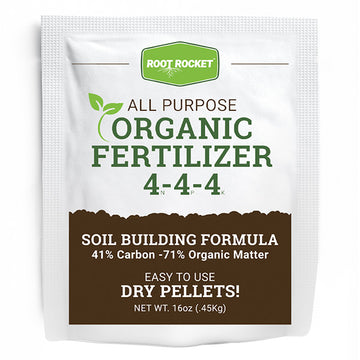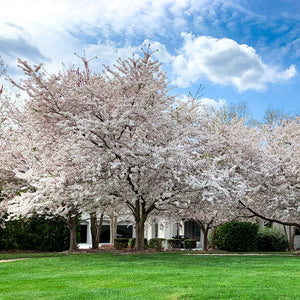Few ornamental trees can match the grandeur of the Yoshino Flowering Cherry. If you’re looking to add color and vibrance to your yard, the Yoshino Flowering Cherry doesn’t disappoint. The magical pink flowers that appear on this tree, also known as sakura, usher in spring with a sensational display of color! This prized and historic tree, first commemorated in 1912, is a symbol of the ongoing friendship between Japan and the United States.
Yoshino Flowering Cherry Facts
Growing Zones: 5 to 8
Bloom Color: Pink and white
Mature Height: 20-30 feet tall
Mature Width: 20-30 feet of arching branches
Growth Rate: 1-2 feet per year
Soil Types: Well-drained
Light Requirements: Full sun
Water Requirements: Mildly drought tolerant
Bloom Time
 The Yoshino Flowering Cherry tree is arguably one of the most aesthetically pleasing ornamental trees you can plant in your yard or garden. If you are starting out with a young, unestablished tree, you may be wondering when you can expect your Yoshino Cherry to bloom for the first time. As a general rule, you can expect the first blooms to appear in the second or third year after planting. However, the Yoshino Cherry tree will showcase its full breathtaking display between years five and seven.
The Yoshino Flowering Cherry tree is arguably one of the most aesthetically pleasing ornamental trees you can plant in your yard or garden. If you are starting out with a young, unestablished tree, you may be wondering when you can expect your Yoshino Cherry to bloom for the first time. As a general rule, you can expect the first blooms to appear in the second or third year after planting. However, the Yoshino Cherry tree will showcase its full breathtaking display between years five and seven.
Once your Yoshino Cherry tree begins blooming each year, you can expect blossoms to emerge in March or April, depending on where you live. Unless impeded by weather conditions, the beautiful blooms will last a good 2 to 3 weeks. The Yoshino Flowering Cherry blossoms are a beautiful white-pink color. They are extremely prolific and smell faintly of almonds. This tree has a lovely shape that is symmetrical and spreading. After flowering, the Yoshino Flowering Cherry produces a small black fruit that birds really love. These fruits are nontoxic and edible, but not very tasty to humans. As the season progresses and the fall season sets in, the oval green leaves turn into a warm yellow, making this tree a beautiful focal point for the majority of the year.
Lifespan
If you’ve heard that Yoshino Cherry trees have short lifespans, you’ll be happy to know that this isn’t necessarily the case. While they don’t live hundreds of years like oaks, cedars, and redwoods, with proper care, most Yoshino Flowering Cherry trees can easily outlive you. They often live 80 to 100 years. If you want to give your tree the best chance for long-term survival, avoid planting them in highly trafficked areas or areas where they will be affected by compacted soil and bark damage.
Disease & Pest Resistance
It goes without saying that the best way to prevent disease and pests is by taking great care of your tree from the get-go. Location choice, watering, fertilization, and proper pruning practices are the keys to success.
That being said, scale, aphids, and mites are insects that can affect flowering cherry trees. The good news is that you can successfully treat these pests with horticultural oil, neem oil, or insecticidal soap. For severe infections, you can use pesticides like carbaryl, also known as Sevin. If you experience problems with tent caterpillars or cankerworms, you can successfully treat them with the organic pesticide spray, Bacillus Thuringiensis.
For fungal diseases, opt to treat them with fungicides in early spring. Taking proactive steps to prevent infection in the first place is the best way to keep your Yoshino Cherry tree disease free. If your tree does end up with a fungal infection, it is recommended that you treat it with neem oil. However, keep in mind that the entire tree must be coated in order for this method to be effective post-infection.
How To Plant a Yoshino Cherry Tree & Maintain It

The Yoshino Flowering Cherry is a fast-growing, medium-stature ornamental tree that thrives in full sunlight (ideally for at least 6 hours per day). They are mildly drought-tolerant and adaptable to most soil types, as long as the soil is well-drained.
When planting your Yoshino Cherry, dig a hole twice the size of your root ball. When you fill in the soil, you want the root ball to be an inch above the surface, so fill as needed. Then water deeply. For the first three months, while your new plants are getting roots established, be sure to water them regularly. We recommend watering at least twice per week. Once your tree is established, you will only need to water it during extended dry periods. Adding mulch can help minimize watering needs as well. Just be sure that the mulch doesn’t sit against the trunk of the tree, as that can cause your tree to become more prone to pest problems.
Pruning is generally not recommended for ornamental cherry trees, but, if needed, prune the dead, crowded, or diseased branches of your trees in winter or early spring, before blooming begins.
Fertilize your Yoshino Cherry tree when planting and in early spring to give your tree a boost. For best results, be sure to choose a good quality, balanced, slow-release fertilizer.
Propagation
A Yoshino cherry tree can be propagated by grafting, air layering, or via softwood cuttings. Which method works the best? While all of these methods work well, for ease of use purposes, air laying is the most simple option. The following is a breakdown of what air layering entails:
The tools you’ll need to complete this project include plastic wrap, grafting tape, a sharp knife, and a nice handful of sphagnum moss. To air layer, you will do the following:
- First, make two parallel cuts around a branch at least 3/8 inches thick and 2 inches apart. Remove the bark from the branch down to the cambium, which will interrupt your cutting from receiving nutrients or water.
- Wet the handful of sphagnum moss and wrap it around the bare wood. Next, cover it with plastic wrap, and tape the ends so that no water can enter or escape.
- Examine the wrapped area every now and again. You’re waiting for roots to develop and a full rootball to get established. Once the root ball is established, remove the plastic, cut your new tree below the root ball, and then plant it immediately.
Landscaping with the Yoshino Flowering Cherry
The Yoshino Cherry tree is the perfect addition to your yard or landscape, and there are numerous ways to showcase its beauty:
- Consider planting one tree in the center of your yard to make it a focal point.
- Planting trees in the corners of your yard will both aesthetically ground your property and draw attention to your home.
- Consider planting a few Yoshino Cherry trees in a row, along a driveway or fence.
- Plant your tree near a deck or patio so that it can be admired by anyone spending time outdoors.
- If you have any large picture windows in your home, consider planting your Yoshino Flowering Cherry where you can see it inside your home and when you venture out.
Yoshino Flowering Cherry Seasonal Care Tips
Here are some professional gardening tips that will help your Yoshino Flowering Cherry tree thrive in all seasons of the year:
Spring Care Tips
- Spring is the ideal time to transplant your young Yoshino Cherry tree. For added support and protection of your young tree, you may want to consider purchasing a tree staking kit.
- If you wish to prune an ornamental tree like the Yoshino Cherry, it’s best to do it either early in the spring or in the winter after it’s gone dormant.
- Mulching in the spring is a great practice that will help your tree retain moisture and ultimately reduce how frequently you need to water it.
- Applying a slow-release, high-nitrogen fertilizer in the spring will produce better blooms and help your trees grow more vigorously.
Troubleshooting tip: If you find that your Yoshino Cherry tree isn’t blooming in the spring, it’s usually the result of negative weather conditions such as untimely frost, insufficient amounts of water, or improper pruning.
Summer Care Tips
- Once the Yoshino Flowering Cherry tree is well established, it won’t require much maintenance. If you live in an area that is dry or prone to long periods of heat and drought, you may need to do some extra watering. This is particularly true for young plants.
Fall Care Tips
- If you didn’t get around to planting your Yoshino Cherry tree in the spring, fall is the next best season to do it.
- For established trees, mid to late fall is an excellent time to do some light pruning.
- Giving your trees a little extra water and some leaf or hardwood mulch in late fall, just before the ground freezes, will help them along quite significantly. This is particularly important for trees that aren’t yet established, as the roots won’t yet be deep enough to suck up water from beyond the frost line.
- Try adding a winterizing fertilizer in the fall to make your trees more resistant to cold winter temperatures. This is even more important if you didn’t fertilize in the spring.
Winter Care Tips
- If you live in a cold and snowy winter climate, securing a light screen or windbreak around your newly planted trees will help minimize potential wind damage.
- Remove heavy snow piles from around your young trees, before it has a chance to freeze or become a solid icy mass. Leaving snow piles around young plants and small trees can cause them to topple over, damaging their fragile root system.
With proper care, your Yoshino Cherry tree will thrive for many years.
The Yoshino Flowering Cherry Tree is for sale online at PlantingTree. For more ideas and inspiration, be sure to check out our complete online plant nursery. View our Flowering Cherry Tree collection and our Gifts for Gardeners collection.
You May Also Like:


